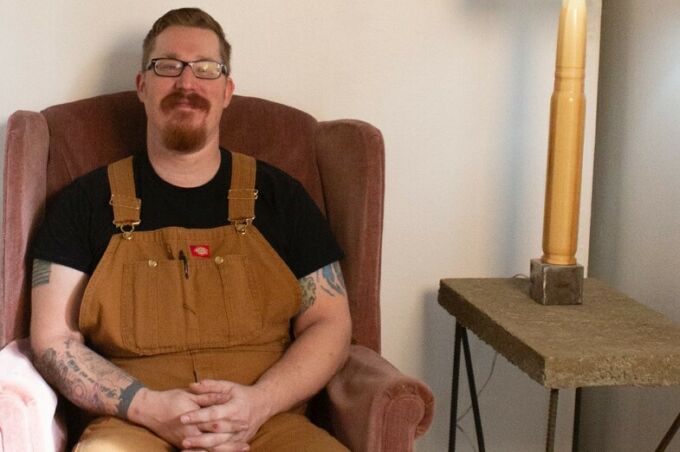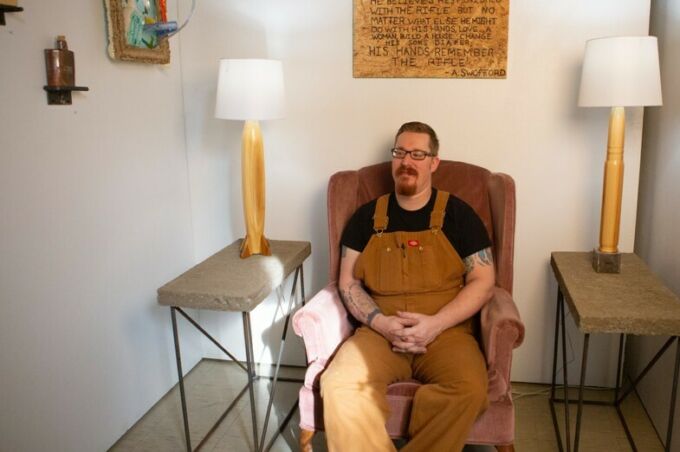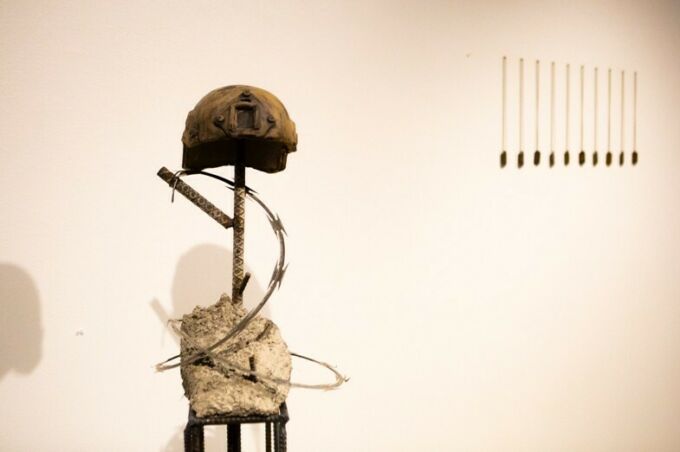November 20, 2019
Ceramics student’s “Canteen Project” offers veterans an artistic outlet to manage emotions of resettlement
During his time in the Air Force as a munitions and weapons system technician, Andrew Storck carried missiles and loaded bombs onto the fighter jets in Alaska that protect our country’s northwest border. And by his side was a trusty companion that could tell quite the story – his canteen.
In 1900, Lieutenant Colonel Philip Reade delivered the “Report Upon Army Canteens” to the Army Inspector General, which highlighted the antiquated nature of the 19th-century water vessels. The report led to a redesign of the canteen and designated it as a standard issue item that every enlisted soldier in the U.S. Armed Forces would receive on their first day of training.
Reade wrote in the report, “It is submitted that a man will retain things for the preservation of his own life longer than he will retain things for the taking of life. Hence he will hold on to his provisions longer than retain implements, such as his gun, cartridges, knapsack, pioneer tool, or even his stock. In other words, the soldier will include his canteen as one of his best friends. He is never prodigal with his water when inured to war experiences. City dwellers who know that there is always plenty more in the pipes do not appreciate this last fact.”
Storck was issued his canteen in 2005 when he enlisted in the Air Force two years after he graduated from high school in Allentown, Pennsylvania. Alaska is where he spent the final years of his service, and in 2015, after concluding his time in the military, he was faced with a harsh reality that many veterans face.
I enjoyed my time in the military, but, like so many others, my training was highly specialized and unless civilian airlines are going to start carrying weapons, those skills are obsolete. It was a tough reality and made re-entry into society incredibly difficult. I felt lost in a sense. – Andrew StorkWhile working toward a degree at Lehigh Carbon Community College, Storck discovered ceramics, which provided him an artistic outlet that allowed him to explore the emotions that accompanied re-entry. A deep connection to the art form was forged and to further develop his skill, he applied to and was accepted into Penn State’s School of Visual Arts. As his artistic voice was maturing and becoming heard in the art world, he maintained his connection to veteran’s issues through groups such as the Combat Art Collective, an organization formed to unite and empower military veteran artists by creating a platform for the artists to share their work. “This made me realize that there are other veterans out there that are like me. It was refreshing,” Storck said. “But it also made me realize that there are so many veteran artists out there that want to share their stories through art, and I wanted to help them.” That desire to give back steered much of his work, and during his more than two years at Penn State he has been an advocate for veteran artists, constantly working to bring their voices to a wider audience. As he entered his senior year at Penn State, Storck was driven to conceive an idea that captured the spirit of his devotion to veteran artists while adding to the national conversation around the complications veterans face when re-entering society. “All of my thoughts kept coming back to the canteen,” Storck said. “It is the one thing that connects military service members from all branches. The canteen is with all of us.” The result of his vision is what Storck calls “the canteen project.” Acting on requests he receives from various online veteran’s groups promoting the project, Storck creates a ceramic canteen that is devoid of color, but in form is unmistakable, and simply ships it to the service member with the understanding that the “blank canvas” is to be used to artistically express his or her story. After months of tinkering with ways to mass-produce the ceramic canteens, and to simply raise the money to advance the project, the requests started to come in by the dozens. Storck has curated a collection of the decorated canteens that he intends to grow and display in galleries across the country as a way to advance the conversation on veteran’s issues. In a recent exhibition in Zoller Gallery on campus, 28 elaborately decorated canteens sat nestled in a bed of sand propped up by a foundation of cinderblocks. With bright colors or muted tones, copper barbed wire or broken tops, each canteen offered a glimpse into the experiences of the soldier who created it. “We’ve sadly come to a point in our society where every veteran has some sort of PTSD and being a part of conversations about how to manage the challenges of re-entry, and functioning in society, has been profound on so many levels,” Storck said.
Instead of saying we’re broken, we can say that we still have things to offer and I hope that this project can help veterans to get to that point. – Andrew StorkThe canteens will be a part of an exhibition in Houston, Texas, in 2020 that is being hosted by Warriors in Art, a Houston-based nonprofit organization that provides artistic opportunities for veterans to develop their creative skills, network with other veterans and community-based artists, and enrich their lives, as well as the lives of others through meaningful expression. Storck is scheduled to graduate in December and while he has not decided where to attend graduate school, he said he will to continue to advocate for veterans through art and, of course, his canteen will be right by his side. If you or a veteran you know would like to artistically express your story using one of Storck’s canteens, please contact him at aks6339@psu.edu.




